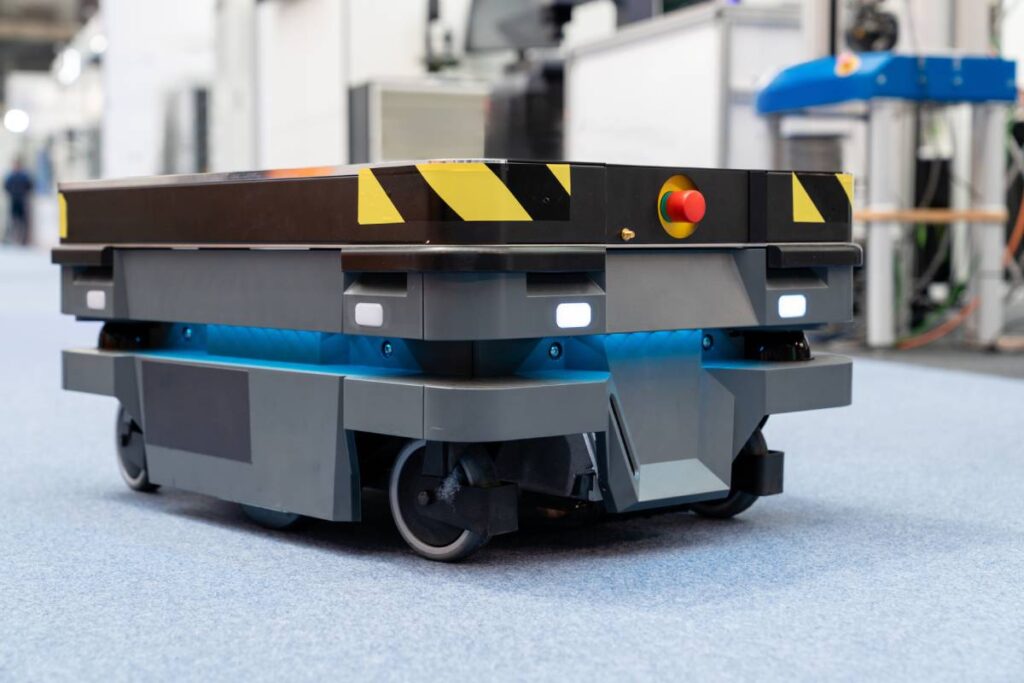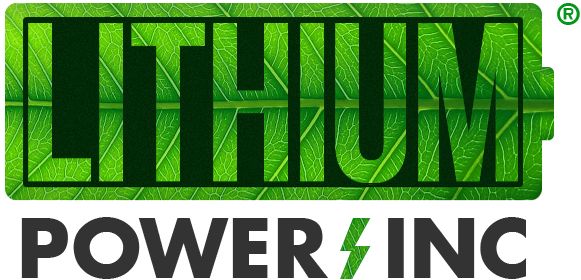
Autonomous Mobile Robot (AMR) Battery Selection Considerations
Executive Summary: Autonomous Mobile Robots (AMRs) are transforming material handling, warehouse automation, and logistics. The battery system is essential to their performance, uptime, and operational costs. This white paper examines the leading battery technologies suitable for AMRs, compares their advantages and limitations, and offers guidance on selecting the right battery based on operational requirements.
Definitions: Foreword: Often confused with each other, AMRs (Autonomous Mobile Robots) and AGVs (Autonomous Guided Vehicles) fulfill similar functions and carry out comparable tasks of transporting materials within designated manufacturing sites and warehouses; however, they differ significantly in the methods used to accomplish this work.
- AMR: AMRs operate independently. They can navigate uncontrolled, guided by input from various information sources, with cameras, sensors, GPS, and sophisticated programming. The most distinctive feature is that AMRs need no fixed paths or tracks for guidance.
- AGV: An AGV follows fixed paths or tracks for material transportation, typically requiring infrastructure changes like magnetic tapes or wires. AGVs also have an array of sensors for location input and safety; the track/path they follow is key to their performance and productivity.
- Introduction: As industries quickly adopt AMRs for tasks like inventory movement, inspection, and delivery, battery performance has become a vital factor in determining reliability, efficiency, scalability, and ultimately, ROI. Selecting the appropriate battery to power the AMR (or AGV) influences:
- how long it can operate
- how fast and powerful is the AMR
- environmental and recyclability considerations
- how quickly it can be charged
- how often it needs to be replaced
- overall safety of the AMR system.
- Key Battery Technologies for AMRs
- 2.1 Lithium Iron Phosphate (LiFePO4)
- Cycle Life: 2000–5000+ cycles
- Energy Density: Moderate
- Power Density: High
- Safety: Excellent thermal and chemical stability
- Charging Time: Fast (typically 1–2 hours)
- Environmental Sourcing: Low – Moderate
- Recyclability: Low
- *Relative Cost: $45-$60/kWh (cells only)
- 2.2 Lithium Nickel Manganese Cobalt Oxide (NMC)
- Cycle Life: 1000–2000 cycles
- Energy Density: High
- Power Density: Medium-High
- Safety: Moderate
- Charging Time: Moderate – Fast (1–2.5 hours)
- Environmental Sourcing: Low
- Recyclability: High
- *Relative Cost: $110 – $120/kWh (cells only)
- Best Use Cases: Compact AMRs or mobile robots are used in constrained spaces where size and weight are critical.
- 2.3 Lithium Titanate (LTO)
- Cycle Life: 10,000+ cycles
- Energy Density: Low
- Power Density: High
- Safety: Exceptional
- Charging Time: Ultra-fast (<30 minutes)
- Environmental Sourcing: Moderate
- Recyclability: High
- *Relative Cost: $990 – 1,100/ kWh (cells only)
- Best Use Cases: AMR operates in 24/7 environments with frequent opportunity charging, such as airports or large-scale fulfillment centers.
- 2.4 Sodium Ion (SI) (emerging technology starting to make inroads)
- Cycle Life: 4,000 – 5,000 cycles
- Energy Density: Low
- Power Density: High
- Safety: Exceptional
- Charging Time: Ultra-fast (<30 minutes)
- Environmental Sourcing: Exceptional
- Recyclability: High
- *Relative Cost: ~$87-90/kWh (cells only) (IDTechEx suggests costs could drop ~$50/kWh by 2030)
- Best Use Cases: Reasonable use in a moderately controlled temperature environment where power density is prioritized over energy density. Accelerating ROI over time while addressing environmental concerns.
- 2.1 Lithium Iron Phosphate (LiFePO4)
- Evaluation Criteria for Battery Selection
- Cycle Life and Durability: Determines long-term cost and replacement frequency.
- Energy and Power Density: Affects the AMR’s size, weight, and endurance.
- Safety and Stability: Important in human-shared workspaces.
- Charging Speed: Influences uptime and need for opportunity charging.
- Temperature Range: Determines viability in cold storage or outdoor applications. (consider the addition of a heater)
- Battery Management and Charging Strategies
- Battery Management Systems (BMS): Critical for ensuring safety, balancing cells, pack-to-pack balancing in paralleling applications, and optimizing lifespan.
- Ability to Series and/or Parallel multiple batteries.
- Opportunity Charging: Useful in high-utilization environments to reduce downtime.
- Swappable Battery Packs: These can enhance flexibility in operations but increase maintenance complexity.
- User Feedback and Monitoring: Ability to gain access to important data such as state of pack health, state of charge, cycle life, pack abuse, and predictive EOL.
- Battery Management Systems (BMS): Critical for ensuring safety, balancing cells, pack-to-pack balancing in paralleling applications, and optimizing lifespan.
- Some Leading Battery Cell Suppliers for AMRs
- BYD & Gotion: Strong in LiFePO4 battery packs with industrial-grade performance.
- LG Energy Solution & Panasonic: Offers compact NMC cells with high energy density.
- EVE Energy, CATL, & Molicel: Provide a broad range of lithium cells with reliable performance.
- Saft & VARTA: Focused on customizable industrial battery solutions for niche AMR applications.
- Toshiba: The leader in Lithium Titanium Oxide (LTO) with its SCiB technology.
- Natron, CATL, & Faradion (others soon): These are some of the leading makers of Sodium Ion battery cells.
- One Leading AMR/AGV Battery Pack Supplier:
- Lithium Power, Inc.
4000 Moorpark Ave, Ste 105
San Jose, CA 95117-1838
United States
Tel: (408) 837-0206
Email: info@lithiumpowerinc.com
Web: www.LithiumPowerInc.com
- Lithium Power, Inc.
- Future Trends
- Solid-State Batteries: Potential for higher energy density and improved safety.
- AI-Optimized Charging: Predictive algorithms to extend battery life and minimize downtime.
- Modular Battery Systems: Allow quick adaptation of AMRs to different tasks or runtime needs.
- Supply Chain: Continued investment in cell & pack manufacturing expansion in the USA and globally.
- Environmental: as battery implementation increases, so does the likelihood of environmental pressures. Significant investment in the lifecycle ecosystem is necessary to mitigate the potential
adversity.
Conclusion
The choice of battery technology significantly influences the performance, safety, and lifecycle cost of Autonomous Mobile Robots. By aligning battery characteristics with operational demands, businesses can ensure maximum ROI and operational efficiency from their AMR investments.
About Lithium Power, Inc.
LPI uses AI tools from beginning to end to develop battery solutions that power AI-driven devices.
An elegant and wonderfully conceived model for success.
LPI is your premier choice for state-of-the-art lithium battery design and manufacturing solutions. From inception to delivery and battery end-of-life, LPI leverages AI tools and innovative processes, along with a firm
commitment to personalized customer service in a traditional manner. LPI is transforming the AMR and AGV industries, one battery at a time. Our skilled engineers and technicians provide custom, high-performance, reliable, and safe battery solutions tailored to your unique, demanding needs and engineered to pass even the most rigorous certification testing.
LPI’s advanced manufacturing facility and strict quality control processes ensure that every Lithium Power battery pack surpasses industry standards.
Join us on the energy revolution journey and explore the true potential of lithium batteries in your applications with Lithium Power’s proprietary technology and dedication to excellence.
OUR UNIQUE BATTERY TECHNOLOGY BREAKTHROUGHS
- Proprietary BMS with multi-level protection parameters
- Drop in replacement lead acid batteries
- UN, IEC, and UL safety certifications
- Cell and pack balancing for parallel scalability
- User configurable battery settings
- Remote monitoring and management
- Intelligent BMS with communication ability
- Robust IP-rated mechanical design
Sources:
www.Sodiumbatteryhub.com / www.marketsandmarkets.com / www.Blackridgeresearch.com / www.NatronEnergy.com / https://www.linkedin.com/pulse/lithium-titanate-li4ti5o12-lto-batteries-guide-vijay-tharad-akdjc/ / www.toshiba.com / https://www.asme.org/topics-resources/content/sodium-ion-batteries-are-powering-up. / https://www.evlithium.com/Blog/benefits-sodium-ion-battery-na-ion-battery.html. / https://www.reddit.com/r/electricvehicles/comments. / https://www.idtechex.com/en/research-report/sodium-ion-batteries/978#. / https://www.mining.com/sodium-ion-batteries-could-rival-lithium-ion-in-cost-stanford-study-finds/ / General Google-Gemini search /
